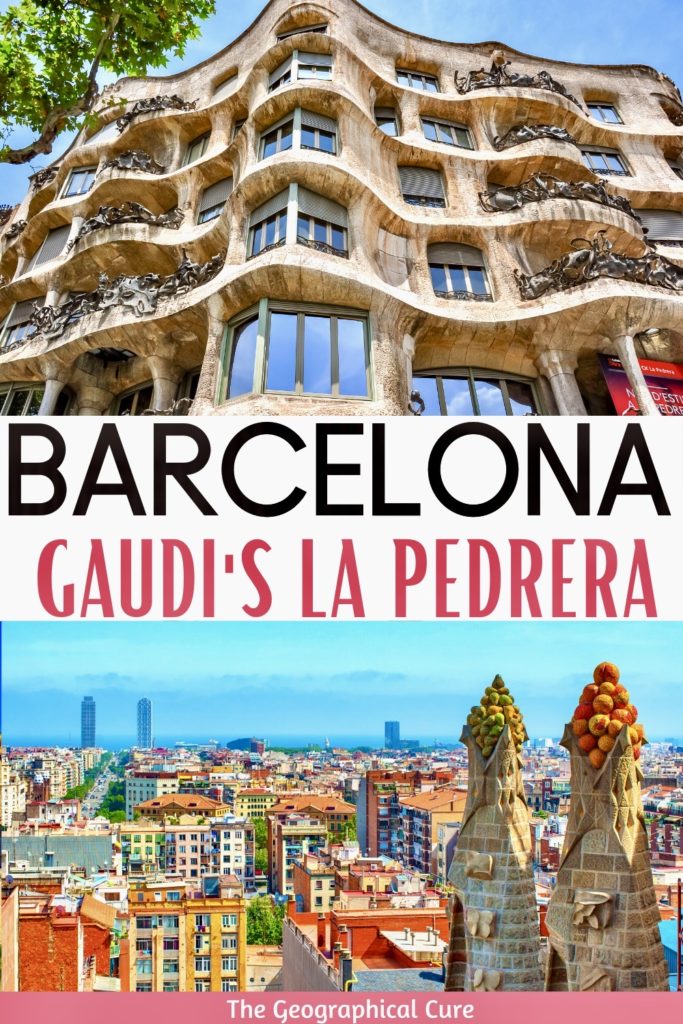La Pedrera, also known as Casa Mila, is the fantastical creation of Antoni Gaudi, one of Spains’ greatest architects. Famous for its undulating stone facade and twisting wrought iron balconies, the structure is a masterpiece of early 20th century architecture and a UNESCO World Heritage Site.
Built between 1906-12, La Pedrera is one of two civic buildings designed by the famous architect Antoni Gaudí on the tony Passeig de Gràcia. The other is the gorgeous Casa Batllo, just down the street.
In 1900, Passeig de Gràcia was Barcelona hot spot. Iconic buildings sprang up. The rich and famous moved in, competing with each other to build bold, expressionistic homes.
In this guide to La Pedrera, I give you an overview of the building, tell you everything to see inside, and give you tips for visiting.
Quick Tips
- pre book a skip the line timed entry ticket to avoid lines
- you’ll be able to see the first floor, an apartment, the attic, and the roof
- decide whether to go during the day or at night
- the best time and least crowded time to visit is first thing in the morning
- if you have ticket, go to the entrance on Carrer Provença
Who Was Antoni Gaudí?
Gaudi was born in 1851 to humble origins. He showed an early predilection for architecture. He attended the Provincial School of Architecture in Barcelona. His eccentric talents were immediately apparent.
Despite poor grades, Gaudí eventually graduated. The dean of the school remarked: “I am not sure to whom I presented a diploma today, to a madman or to a genius.”
To me, Gaudi seems to have fulfilled his instinctive genius. His creations are so unique. They all reflect his life long belief that nature was the best inspiration.
Over Gaudí’s 50 years of independent practice, he concocted and realized some of the most imaginative architectural forms in history. They are mostly in Barcelona, but there is a beautiful villa in Comillas as well.
Mini History of La Pedrera
Gaudí’s Commission
La Pedrera was commissioned by a wealthy widow and her second husband, Pere Milà and Roser Segimon.
Pere Milà, who had a rather flamboyant lifestyle, had seen the acclaimed Casa Batlló. He fell in love with it, and was wildly enthusiastic about its creative Art Nouveau beauty. And its architect, for a short time …
The couple intended to make the main floor of La Pedrera their home and rent out the apartments above.
Gaudi’s Preferred Architectural Plan
Although instructed to design a house like Casa Batlló, Gaudí had other ideas.
True artists don’t like to replicate a piece. They await inspiration. And they don’t take directions.
Presaging his Sagrada Familia obsession, Gaudí wanted the building to be a spiritual symbol, an homage to the Virgin Mary.
But many of his thematic decorations and statues for the facade and rooftop were nixed or removed by the owners. Religious allusions might cramp anyone’s newly-wedded bliss.
The construction dates also coincided with an outbreak of anticlericalism. The couple didn’t want to be the target of anarchists.
The resulting building isn’t exactly what Gaudí envisioned. Or what the Milàs wanted.
Or what anyone envisioned. La Pedrera is, in fact, quite the opposite of Casa Batlló.
It’s a statement building. In terms of ingenuity, architectural design, and style, it was even more revolutionary than Casa Batlló. Nothing like it had every been seen before. Or since, really.
Gaudí was working at the height of his powers. La Pedrera would be Gaudí’s last civic work before committing himself full time to Sagrada Familia.
Gaudi’s Poor Client Relation Skills
A temperamental Gaudí didn’t get on terribly well with his clients. They clashed. And that fact was well known by the locals.
Gaudí had a stereotypical artistic personality. He was impulsive and volatile.
He constantly changed his mind about the building’s shape, was way over budget, and violated building codes willy nilly. The Milàs paid large fines for his fickle violations.
Gaudí almost abandoned the project entirely at one point, when his plans for the installation of religious statues were scuttled.
For example, Gaudí wanted a massive Virgin Mary statue on the rooftop.
He argued that the Milàs wouldn’t see it all that much. Roser refused to let Gaudí install it.
Gaudí ultimately complied, in his own inimitable way. He gave the statue to the Milàs’ neighbors for them to install on their roof. As a result, the Milàs would still suffer whenever they took a rooftop stroll.
When Roser Segimon complained there was no flat wall for her Steinway piano, Gaudi answered “So play the violin.” (This may be apocryphal.)
Segimon’s revenge was to banish all Gaudi decorations and furniture from her house after Gaudi’s death and redecorate in a Louis XVI style. Sadly, many of his creations are now lost to posterity, though a few are on display.
Gaudí even went to court to get the Milàs to pay his overblown fees. He won the case. Then, he promptly donated the cash to a nunnery to thumb his nose at the Milàs.
Public Outcry Over La Pedrera
Initially, there was public outcry over the odd appearance of La Pedrera. It was controversial, heterodox. It was repeatedly ridiculed as an ugly fortress.
The public didn’t much like its unconventional appearance. The building didn’t have the whimsical charm or appealing dragon legend of Casa Batlló.
It was comparatively plain. It wasn’t remotely what the Milàs had ordered.
The rough hewn building was nicknamed “The Quarry” because of its jagged, rocky facade and weird undulating shape. It was satirized with cartoons in local publications.
Other home owners were angry with the Milàs, arguing that their concoction reduced the neighborhood’s real estate values.
But La Pedrera had its revenge for the initial disparagement.
La Pedrera’s Revenge
La Pedrera is now considered one of the crown jewels of the Art Nouveau movement. It’s been used in 15 movies. (To me, the rooftop is reminiscent of Tatoine in Star Wars.) It’s a main setting in Dan Brown’s 2017 novel, Origin.
What Sagrada Familia is to churches, La Pedrera is to urban living.
The building was eventually sold and subdivided. By 1980, La Pedrera was in poor shape.
It was repainted a dreary brown and the vibrant interior paintings were faded. Thankfully, it was restored in recent decades and became a UNESCO site in 1984.
It’s now owned by a bank, Fundació Catalunya-La Pedrera, which commissioned the restoration work. The building serves as a cultural center, often hosting temporary exhibitions.
Most people seem to prefer Casa Batllo just for the sheer weirdness of the facade. But critics consider La Pedrera a more significant Gaudi work.
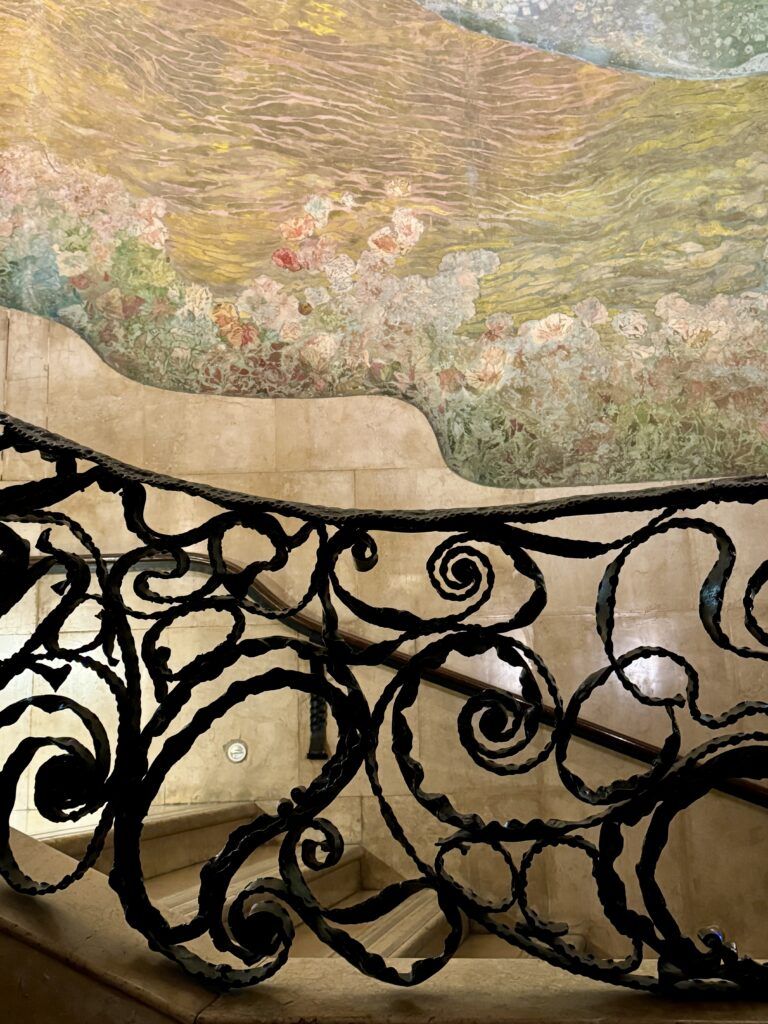
Tickets and Tours For La Pedrera | Casa Mila
You definitely need to pre-book tickets to La Pedrera. It’s a popular spot, with over one million people visiting each year.
Click here to purchase a skip the line ticket for La Pedrera. You can also book a 4 hour guided tour of the architectural wonders on Passeig de Gracia with skip the line tickets.
Gotta see it all? You can also take an 8 hour full day tour of La Pedrera and other Gaudi sites.
In the evenings, a spectacular audiovisual show takes place on the La Pedrera terrace.
The rooftop terrace and stairwells are illuminated with projections set to music. You can enjoy this performance with a glass of cava in hand, which comes with your ticket.
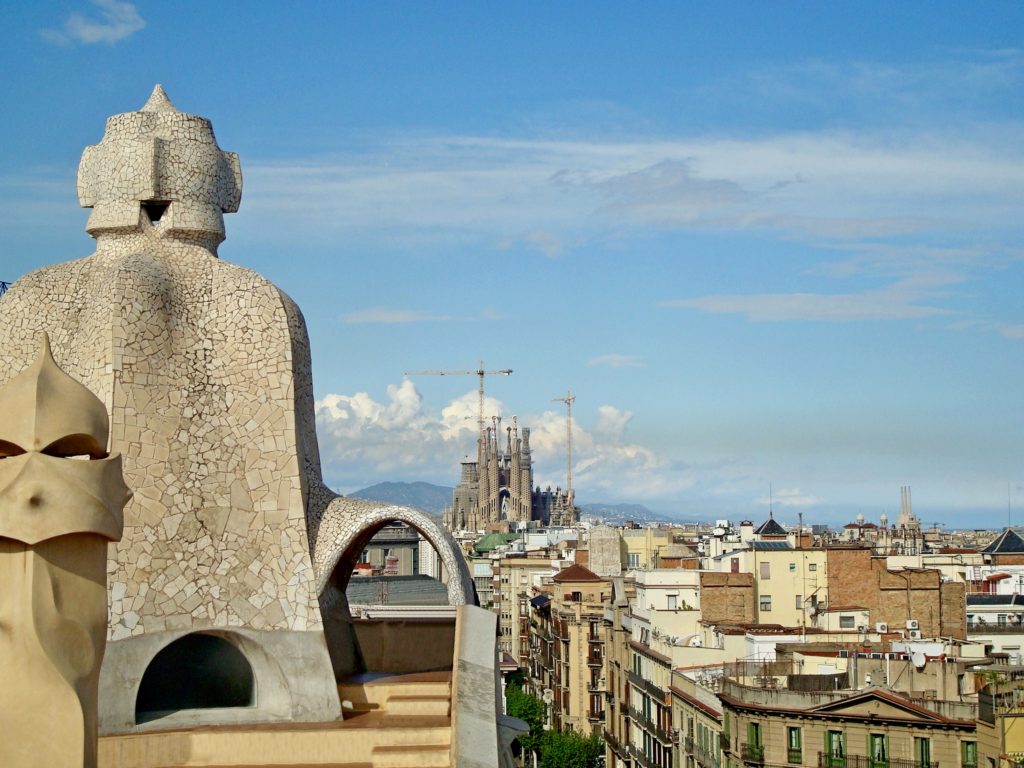
Highlights & What To See at La Pedrera
In classic Gaudí fashion, La Pedrera was heavily influenced by nature — by air, sea, and water. The nature theme is visible in its overall look, down to the tiniest detail. Everything carried forward the theme.
Here’s what you need to see art La Pedrera.
Exterior
Prepare for an open water swim.
The building ripples and waves like a burbling ocean. There’s not a right angle or straight line anywhere.
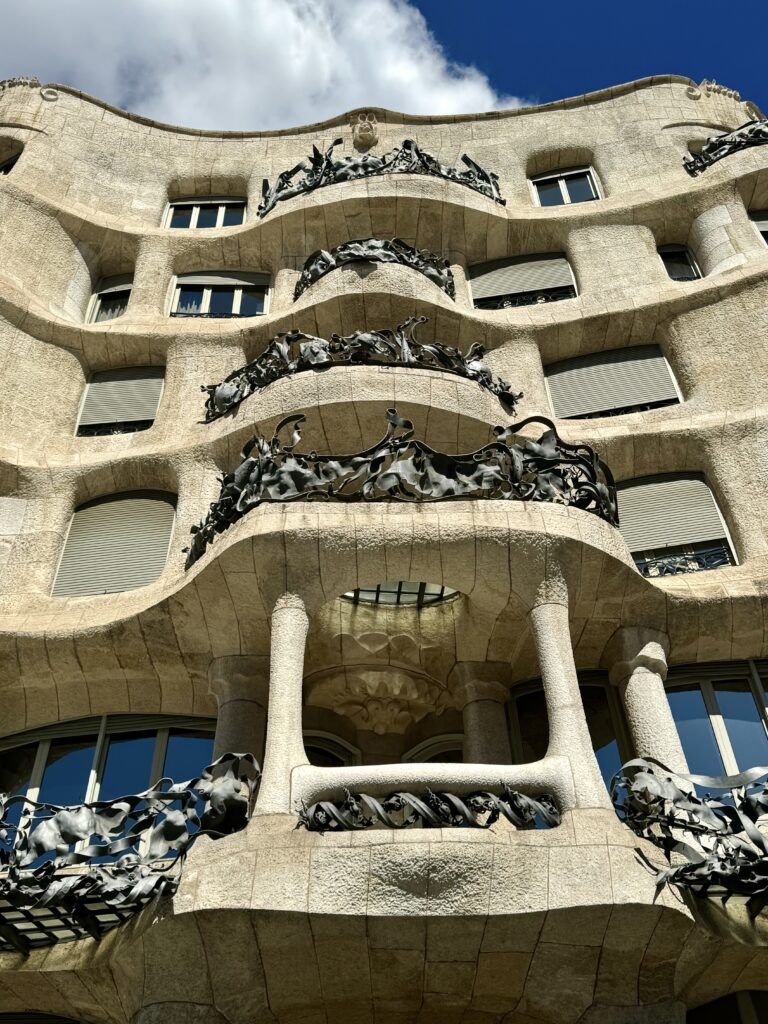
Gaudí wanted it to resemble a “petrified wave.” To that end, he used contrasting elements — a heavy stolid stone facade and a wavy shape.
The undulating facade isn’t a load bearing wall. It’s a self supporting curtain wall that connects to the internal structure of each floor via curved iron beams.
This gave Gaudí freedom to create irregular floor plans. It was one of his cutting edge architectural innovations.
Gaudí deliberately left the exterior in neutral colors for an organic feel. It’s practically monochromatic, colored only by the play of shadows and lights as the sun moves across the sky.
Notice the expressive grills of the 32 exterior balconies. No two are alike. The grills look modeled after seaweed or sea life from the ocean.
They look like they’re moving, being tossed around by waves. Between the building’s curves and the balcony grills, you could be viewing an underwater landscape.
One interesting tidbit. Some of the lower grills in the daylight basements were removed over time as those areas were converted to commercial premises. The grills were considered of little value and discarded.
However, one piece removed in the 1920s turned up in the US. It was donated to the MOMA by a private collector. The grill remains in its collection today.
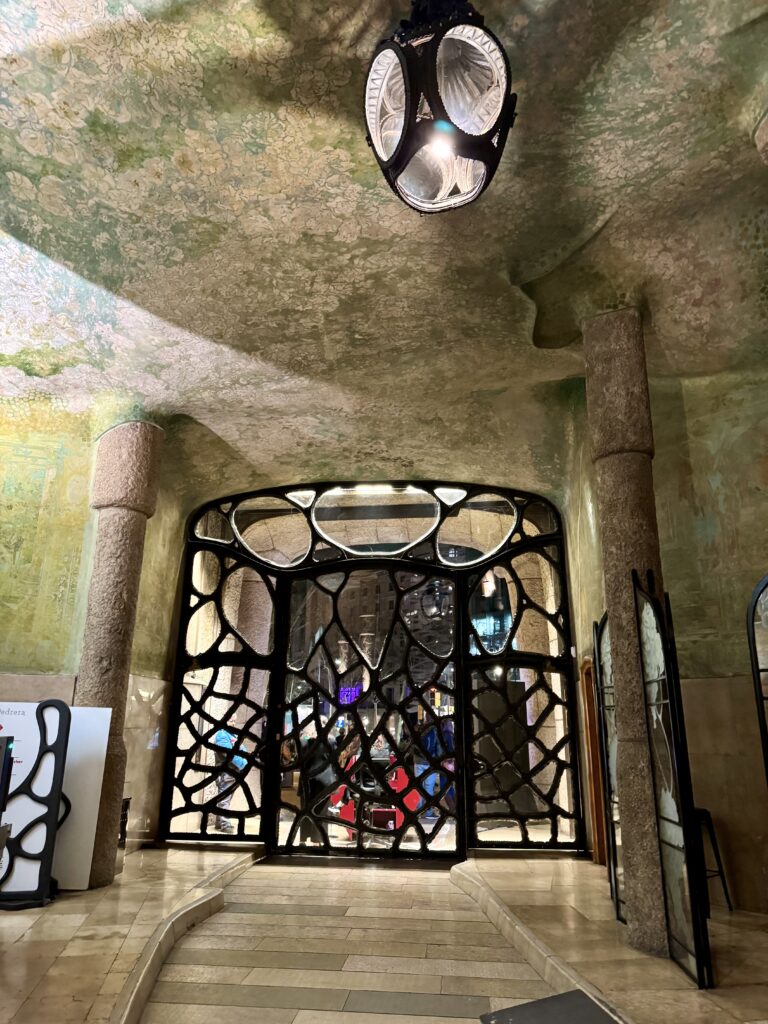
Interior
You enter La Pedrera via an elaborate wrought iron door. To me, its organic forms resemble a large butterfly.
The door was large enough to accommodate both people and cars. La Pedrera was Barcelona’s first residential building to have a parking garage in the basement.
At the time, large panes of glass were unavailable for the door.
So Gaudí used smaller pieces of glass to fill the space, with the smallest pieces at the bottom and the more luminous pieces at the top.
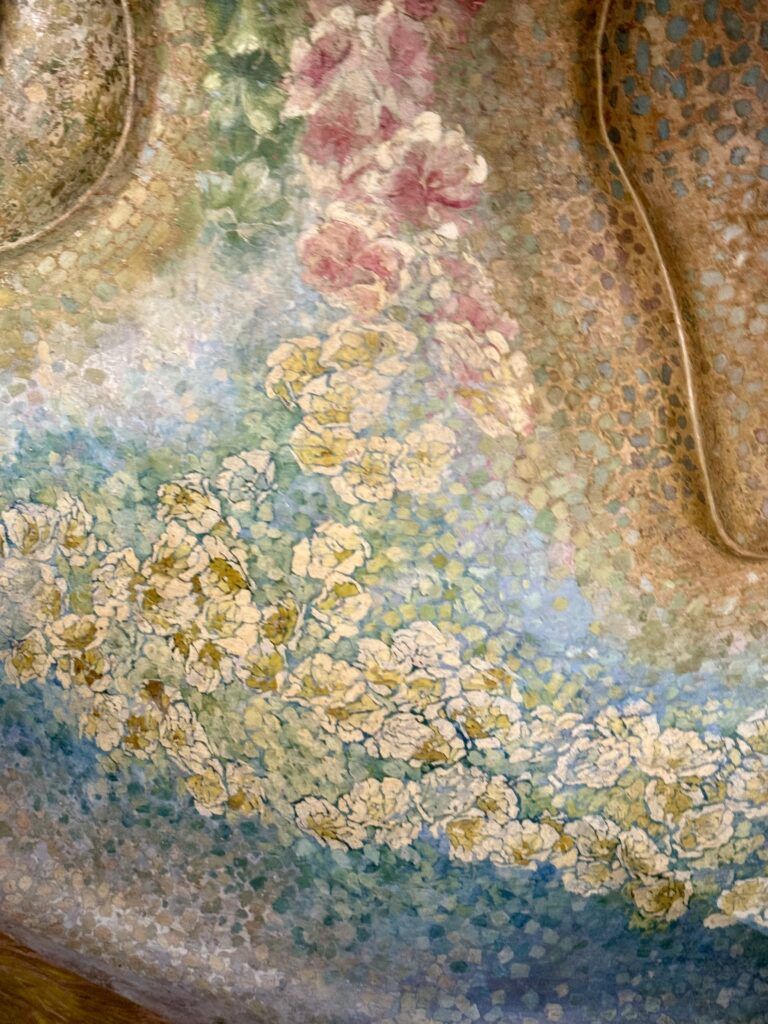
Inside, unlike outside, there’s riotous color.
The paintings in the entrance hall were created and overseen by Symbolist painter Aleix Clapes. The dreamy paintings are tapestry like and contain mythological and floral motifs.
Continuing the marine theme, the tile floor is inspired by sea creatures. The tiles’ relief motives contain octopus, starfish, and conch shells.
The visit to La Pedrera is four parts.
It includes the first floor atriums, the attic, the rooftop, and an apartment with some original Gaudí furnishings. The intricately painted stairs that carry you up to the remarkable roof are also wave-like.
Attic
The attic ceiling on the uppermost floor almost looks like a steeple.
There’s a ribcage of 270 catenary arches made of red brick to support the roof terrace. A mirror allows you to get a close up look at them.
The attic previously was a vast insulating air chamber and used as a laundry room by the residents’ maids.
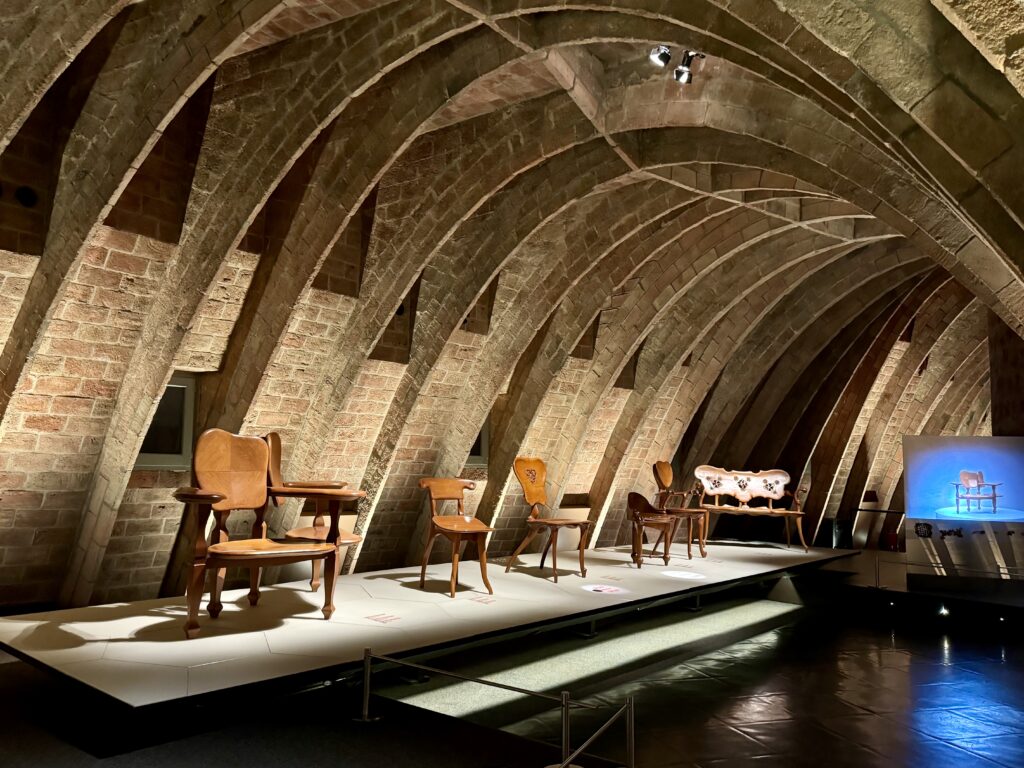
Now, it houses the Espai Gaudi — a sprawling multimedia exhibit tracing Gaudí’s career and showing models, photos, and videos of his work.
You see examples of Gaudi’s furniture to get an idea of his decorating taste. There are videos to watch about the man, his life, and works.
You can also see examples of the lead and string structural models he used to solve load bearing and engineering conundrums.
There are of elements and animals from nature in a display case. You can see how Gaudi used some of the forms when he designed the house.
Apartments
There were 17 apartments altogether. The Milàs lived on the first floor in a spacious 10,000 square foot apartment.
There were 4 apartments on each floor of the building. There are 4 apartments still rented by (obviously very wealthy) private individuals.
If you’re visiting during the day, on the fourth floor, you can visit El Pis de la Pedrera, an apartment decorated in the fashion of a well-to-do family with original Gaudí furniture.
There’s a kitchen, bathroom, bedroom, living room, office, dining room, and children’s room.
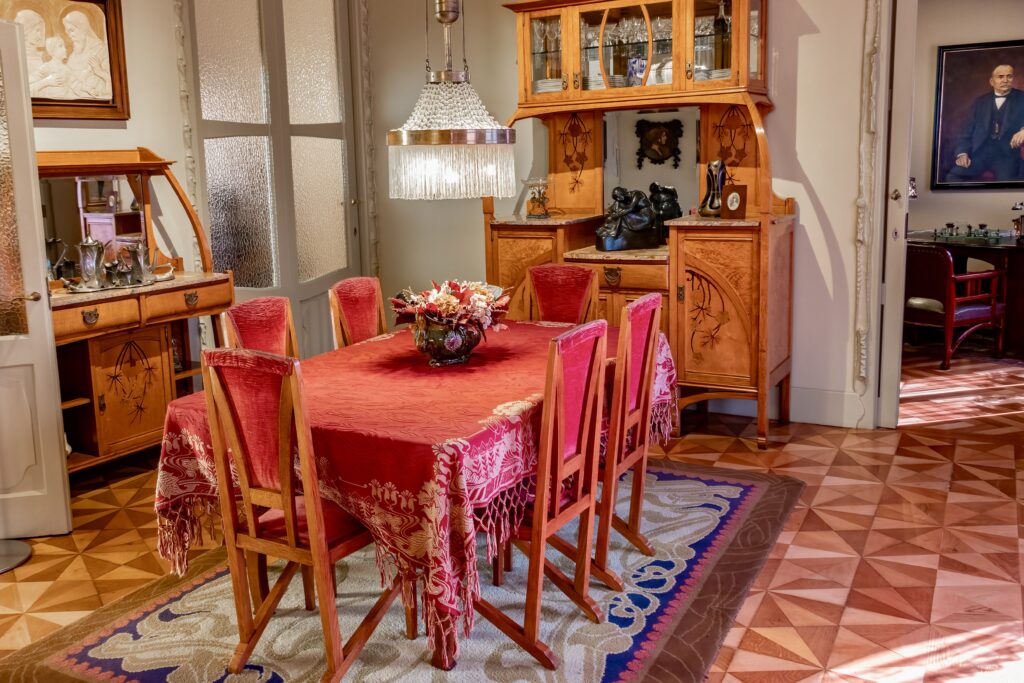
As to be expected from Gaudi, the interior is curvaceous. Whenever possible, he eliminates straight lies in the ceilings, walls, and doors.
Some of the furnishings were designed by Gaudi and some by his top assistance Josep Maris Jujol.
You may want to find yourself moving in!
All in all, it’s incredibly hard to reconcile that someone actually made (and makes) this place their home. I’m honestly rather queasy with envy.
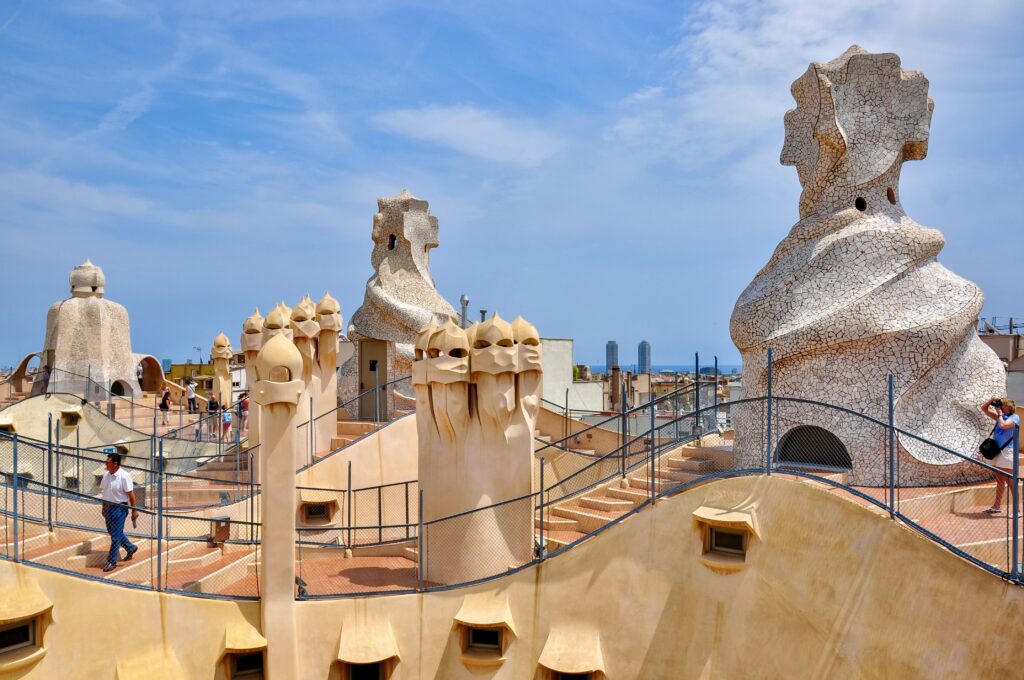
Rooftop
La Pedrera’s rooftop is the highlight of your visit. You access it from the attic.
Poet Pere Gimferrer called it the “garden of warriors.” Once there, you have a lovely view of nearby Sagrada Familia.
The undulating roof has winding pathways and a spiky forest of 30 chimneys. It’s filled with whimsical structures, operatically lording over and guarding the building.
Some chimneys are freestanding structures. Others are joined in groups of 3 or 4. Some are covered with fragments of marble and broken tile.
They all look a bit like militant Stormtroopers from Star Wars. Perhaps George Lucas saw them and was inspired?
The roof levels are uneven, and you’ll have to watch your step.
It’s like a drawing of a fantastical world, brought to life. More dream landscape than utilitarian roof.
The center opening of the perimeter walkway looks like a massive sinkhole or Masonic initiation well.
You know you’re on a building. But it doesn’t quite seem that way because of the strangeness of the scene.
The windows on the upper level look like the mouths of people, whispering to you. You wonder what they’re saying.
Atriums
There are two separate internal courtyards, one circular and one oval. The apartments swirl around them like river water over boulders.
The first courtyard is circular and more intimate. There are a series of arches and columns that create a sense of rhythm and harmony.
It’s covered by a glass roof, allowing natural light to flood the space while providing protection from the elements.
The second courtyard is simply spectacular and opens up to the sky. You can admire the intricate ironwork of the balconies and the sculptural elements that decorate the space.
One external stairway is covered with a partial roof that looks like the wing of a bird.
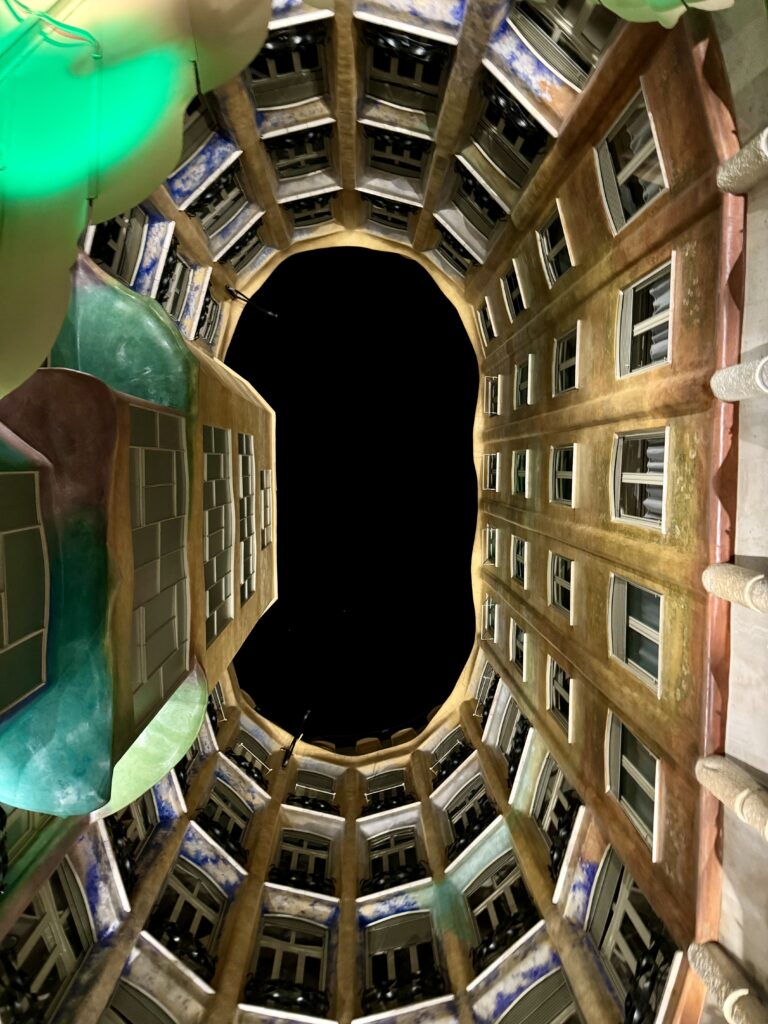
Practical Guide & Tips forLa Pedrera
Address: Passeig de Gràcia, 92
Metro: Diagonal
Entry fee: Seven the basic tickets are rather expensive, starting at 28 euros. You can see the various options to choose from here.
Hours: Summer: 9:00 am to 8:30 pm. Winter: 9:00 am – 6:30 pm. The night tours begin at 8:40 pm. There are 5 time slots to choose from, mostly in English.
Day or Night Visit?
I’ve now visited both during the day and at night. The nighttime tour option is called “the Origins.”
It includes a guided tour of the building (but not the apartment) with the lights lowered and colorful lights projected along the roof. You’ll get a glass of cava in the large courtyard to make your even more surreal.
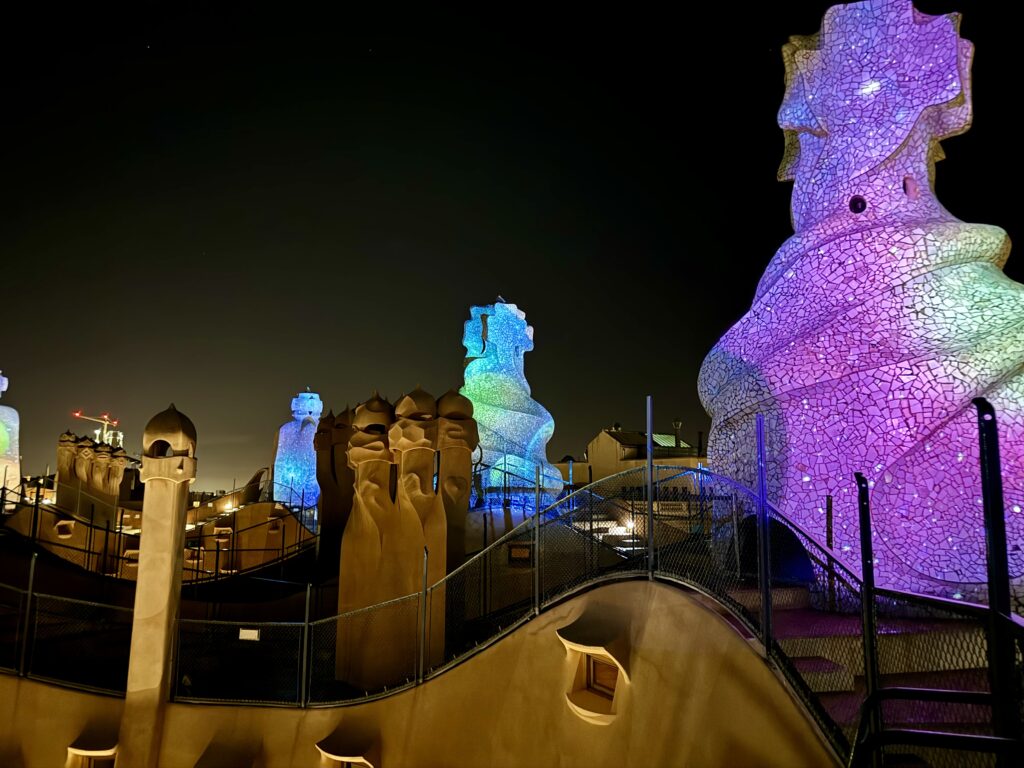
On the whole, I recommend the day tour. You can see the apartment and you don’t have to navigate the roof at night.
I had to turn on my iPhone flashlight to even see the steps. There were very few lights and some of them were burned out.
It struck me as a tad dangerous and something that wouldn’t be allowed in the US. Still, it’s lovely at night and you get a different perspective.
Pro Tips: It’s quite a hike from the first floor to the attic. But there is an elevator available too.
I hope you’ve enjoyed my guide to Gaudi’s La Pedrera. You may enjoy these other Barcelona travel guides and resources:
- 1 day itinerary for Barcelona
- 3 day itinerary for Barcelona
- 40+ Landmarks in Barcelona
- Guide to Sagrada Familia
- Guide to Gaudi Architecture
- Hidden Gems in Barcelona
- Architecture Lover’s Guide to Eixample
- Guide to the Gothic Quarter
Pin it for later.

